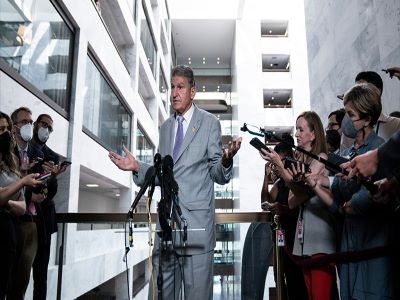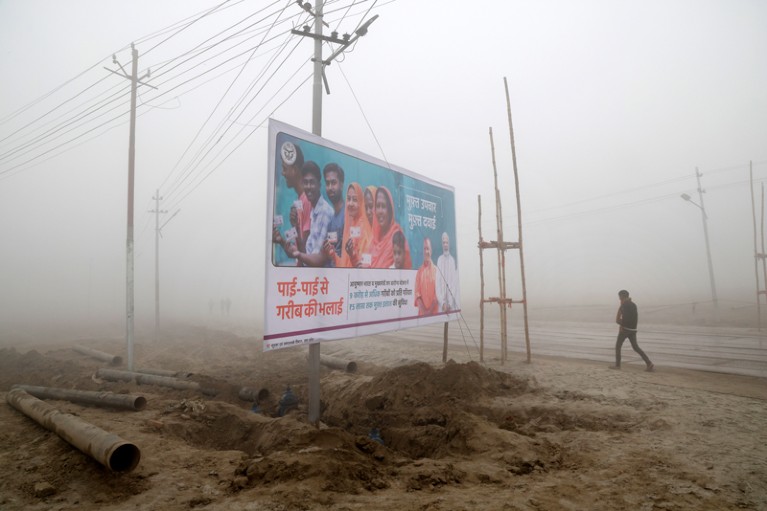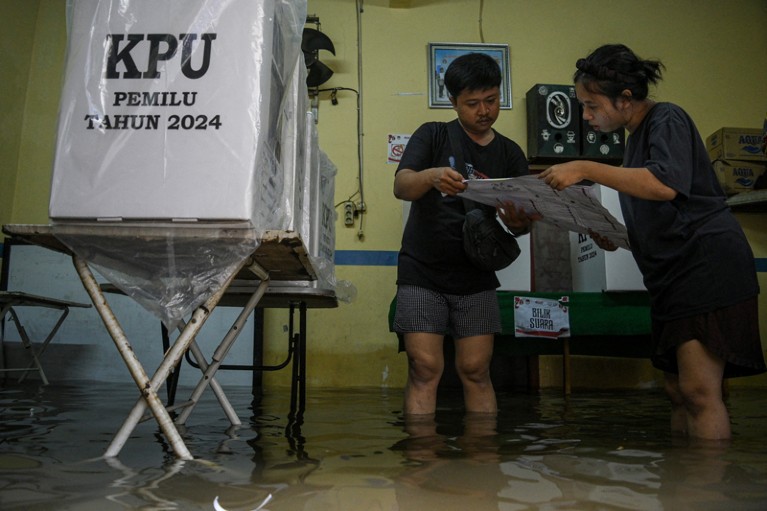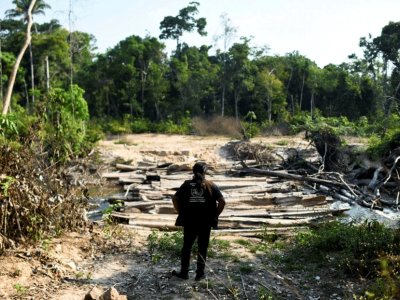This year, voters in five of the world’s biggest carbon-emitting territories go to the polls. These regions — the United States, India, Indonesia, Russia and the European Union — represent one-third of the world’s population and about the same proportion of human-made carbon emissions.
How the political wind blows from these elections will be crucial in determining whether humanity can correct its current trajectory of dangerous climate warming (see ‘Monstrous emissions’). Current climate policies are likely to result in warming of about 2.7 °C by 2100, according to the group Climate Action Tracker, which monitors global climate commitments — well above the 1.5 °C goal laid out in the 2015 Paris climate accord. Long-term climate commitments could prevent another 0.6 °C of warming, but those depend on further action by governments, including many whose leaders are up for election in 2024. It could be a pivotal year.
Source: Global Carbon Budget 2023 (emissions); UN Population Division (population)
United States: Biden versus Trump
In August 2022, US President Joe Biden surprised the world with a legislative victory on climate spending that, by some recent estimates, is likely to lock in nearly US$1 trillion in investment until 2032. This includes direct spending as well as tax credits for everything from wind and solar power to electric transport, carbon sequestration and reskilling programmes for people who currently work in the fossil-fuel sector. One of the Biden administration’s main jobs now is to ensure that the money is invested wisely and keeps flowing if Biden is re-elected on 5 November.
Researchers have estimated that Biden’s flagship achievement, the 2022 Inflation Reduction Act, could double the pace of US climate progress by itself and reduce the country’s carbon emissions by 43–48% by 2035, relative to 2005 levels. That is short of the US commitment to cut emissions by 50% by 2030, also compared with 2005, but the administration is pushing forwards on other fronts, including issuing regulations to reduce emissions from vehicles and power plants. Overall, climate specialists say it’s a historic effort that could help the world’s second-largest greenhouse-gas emitter (behind China) to lead a clean-energy revolution.
“We’ve never seen a decarbonization effort like this,” says Noah Kaufman, an economist at Columbia University’s Center on Global Energy Policy in Washington DC. The Biden administration’s climate agenda has significant momentum, Kaufman says, and another four years would help the administration to lock in progress. “The question is, what happens if we lose this momentum?”

How the biggest US energy bill ever could revive Biden’s climate agenda
Biden’s likely main opponent in the November election, former president Donald Trump, remains hostile to government action on climate, and there is little doubt that he will do everything he can to promote fossil fuels if he wins. He is widely expected to pull the United States out of the 2015 Paris climate agreement — for a second time. The first withdrawal, which came into effect on 4 November 2020, a day after Trump lost his re-election bid, was quickly reversed by the incoming Biden administration. Trump has also said he would use his executive authority to weaken climate regulations and expand federal oil and gas programmes.
But it would be difficult for Trump to override the clean-energy investments in the Inflation Reduction Act. Because those investments were laid out in a law, Congress would need to enact a new one to roll them back, says Samantha Gross, who heads the Energy Security and Climate Initiative at the Brookings Institution, a think tank based in Washington DC.
To have any chance of doing that, Republicans would need to retain control of the House of Representatives and win enough seats to take control of the Senate in the November elections. Even then, Gross says, it wouldn’t be easy. The law is already incentivizing businesses to invest and create jobs in communities across the country, and many are in Republican districts. “Once the economic benefits start flowing, the political calculus changes,” she says.
India: Modi’s climate balancing act
Climate change isn’t high on the agenda in India’s upcoming general elections. But it is crucial to Prime Minister Narendra Modi’s global ambitions, say researchers.
Voting across the vast country will probably take place in April and May. If Modi and his Bharatiya Janata Party (BJP) win a third five-year term, he will be preoccupied with his legacy as a climate leader, says Aseem Prakash, a political scientist at the University of Washington in Seattle.
India is the world’s third-biggest emitter of greenhouse gases. But the country is also home to 1.4 billion people, which is more than one-sixth of the world’s population. Its per-capita emissions are less than one-seventh those of the United States and one-quarter those of China.

In India’s upcoming election, climate action is not a campaign talking point for the two leading parties.Credit: Subhash Sharma/Polaris/eyevine
In 2021, at the COP26 global climate conference in Glasgow, UK, Modi committed to achieving net-zero emissions by 2070. India has also agreed that, with foreign financial and technical assistance, non-fossil-fuel sources will make up about half of its electricity generation capacity by 2030.
The country has backed some of those promises with action. India’s wind and solar power capacity has almost doubled over the past 5 years, to 135 gigawatts. Together with hydropower, renewables now account for 42% of power generation capacity (although owing to the variability of many of the sources, they make up a lesser share of actual electricity production). “It’s a renewables miracle,” says Sangeeth Selvaraju, a sustainable finance analyst at the Grantham Research Institute on Climate Change and the Environment in London.
Under a newly elected Modi, India’s climate policies will “continue in an aggressive manner”, says Suruchi Bhadwal, a climate scientist at The Energy and Resources Institute in New Delhi. These include expansion of solar and wind infrastructure, and investment in green hydrogen development. Last month, Modi’s government presented its interim budget for the year from April, which includes subsidies for offshore wind energy and rooftop solar panels — “two nascent industries that need a real boost”, says Selvaraju.

India and climate: what does the world’s most populous nation want from COP28?
But climate action is not a campaign talking point for the two leading parties, the BJP and the Indian National Congress, say researchers. Instead, the priority is energy security to meet burgeoning demand, which in the short term means more fossil-fuel consumption and a continued reliance on coal. Last year, energy demand peaked in September, and was 13% higher than during the previous year’s peak month of April. Coal still accounts for three-quarters of electricity generation — a reason why India has played a key part in resisting attempts to introduce language about phasing out fossil fuels in communiqués from the past few climate summits.
In September, India’s minister for power, Raj Kumar Singh, said the country might need to build new thermal power plants. “There will be more coal power plants in the next ten years,” says Nandini Das, a climate and energy economist at the policy institute Climate Analytics in Perth, Australia.
In the unlikely event that Modi loses, Selvaraju says he doesn’t expect a shift away from India’s dual push for renewables and coal, “simply because it’s not really in the hands of the politicians”. Unlike in the United States, India’s climate policies don’t flip-flop according to who is in power, says Dhruba Purkayastha, director for India at the non-profit research group Climate Policy Initiative, based in New Delhi.
But climate change should be on the agenda, says Das. From flooding to drought and heat stress, “India is a highly climate-vulnerable country.”
Indonesia: powered by nickel and coal
Indonesians went to the polls on 14 February to elect a new president and legislature. Votes are still being counted, but the majority of the almost 130 million Indonesians who voted look to have chosen a leader who promised continuity with the policies of Joko Widodo, the outgoing president. Prabowo Subianto, a former army general and minister of defence under Widodo, ran with Widodo’s eldest son, Gibran Rakabuming Raka, as his vice-presidential candidate.
“From the perspective of climate change, not much will change,” says Daniel Murdiyarso, a climate scientist and president of the Indonesian Academy of Sciences, who is based in Bogor, south of the capital Jakarta.

The result of Indonesia’s election is unlikely to affect its current climate policies, which reflect an economy that is heavily dependent on coal.Credit: Sulthony Hasanuddin/Antara Foto/Reuters
Researchers say that in the short term, that means more coal consumption and exports, slow progress on reducing deforestation and cheap but dirty nickel extraction. The country is the world’s leading producer of raw nickel, needed to fuel the growing global appetite for electric vehicles, batteries and stainless steel. “Business is probably going to trump any other concerns,” says political scientist Jemma Purdey at the Australia–Indonesia Centre at Monash University in Melbourne.
Even bigger business than nickel is coal. Indonesia is the world’s largest coal exporter, and 60% of its own electricity supply comes from the fossil fuel — a reliance that is locked in for several more decades owing to government support and relatively young power plants. Together with the difficulty of building an electricity grid across Indonesia’s many islands, this is why renewables have not boomed in the country as they have in India or China. “It’s got the resources, and it’s got the conditions to generate a lot of wind and solar power. But the infrastructure and institutional challenges are yet to be tackled for that to happen at scale,” says Selvaraju.
Indonesia aims to reach net-zero emissions by 2060, “but has been fairly non-committal” with that target, says Dirk Tomsa, a political scientist at LaTrobe University in Melbourne. Despite a relatively young voting population, climate and environment were not key issues in these elections, says Ika Idris, who chairs the Monash Climate Change Communication Research Hub Indonesia Node, and is based in Jakarta. “During the campaign, none of the candidates really focused on that.”

Indonesian election promises boost to research funding — no matter who wins
Some popular initiatives that Subianto is likely to inherit include support for the development of a home-grown electric vehicle industry, as well as construction of a renewables-fuelled green city, Nusantara, which is set to become Indonesia’s new capital later this year. But even these were framed as economic development and not climate issues, says Idris.
In 2020, Widodo banned exports of raw nickel to strengthen domestic processing, which is highly carbon-intensive. Subianto’s win will probably see continued prioritization of nickel mining and processing to fuel the country’s economic development, at the cost of concerns about local environmental pollution and worker safety, say researchers.
Indonesia is also home to some of the world’s largest tropical rainforests, peatlands and mangroves. Under Subianto, researchers expect Indonesia to adhere to its international commitments to reducing deforestation — the rate of forest loss there has declined over the past five years — while also strengthening the palm-oil industry, which adds to pressure on rainforests and carbon-storing peatlands.
Russia: the smog of war
In March, Russian leader Vladimir Putin will begin a fifth term as president following an election, the result of which is not in doubt. Climate change will not feature in a campaign that Putin will use to claim endorsement of Russia’s invasion of Ukraine and rally anti-Western sentiment.
The ongoing war and economic sanctions — imposed by the European Union and countries including the United States and United Kingdom — are likely to hinder future climate action in the world’s fourth-largest greenhouse-gas emitter, says Marianna Poberezhskaya, who studies Russian climate politics at Nottingham Trent University, UK.

Politics and the environment collide in Brazil: Lula’s first year back in office
“Major shocks like economic crises, and obviously the war, the worst of them all, makes the already quite weak climate position and policy in Russia even weaker,” says Poberezhskaya. This is despite the nation already experiencing severe wildfires and flooding owing to climate change in recent years.
Russia is aiming to cut greenhouse-gas emissions by 70% compared with 1990 levels by 2030, and to reach carbon neutrality by 2060. The nation’s emissions are already around 30% below 1990 levels, with most of this reduction due to deindustrialization following the collapse of the Soviet Union in 1991. According to Putin’s regime, these goals will be met through the expansion of forest carbon sinks, carbon capture and storage technologies and a continued reliance on nuclear power and hydropower.
The plan to cut emissions does not include a phase-out of fossil fuels, on which the Russian economy is highly dependent. “Russia is not itself going to reduce its fossil-fuel economy. If it goes down, it is because of other countries’ policies — Russia will clearly sell fossil fuel as long as someone buys it,” says Anna Korppoo, who studies Russian climate policy at the Fridtjof Nansen Institute in Fornebu, Norway. Proposed targets to expand tree-based carbon sinks are unlikely to be met, she says: these sinks are currently in decline and there are no national policies to reverse the trend.
The detrimental impact of Russia’s war in Ukraine on Arctic climate science will also continue. Russia covers almost half the landmass of the Arctic, but in March 2022, immediately after the invasion, the seven other countries on the Arctic Council, which discusses sustainable development and environmental issues in the polar region, suspended cooperation with Russia. Russian data have been excluded from Arctic climate models and from research on the impacts of climate change on Arctic people and ecosystems, and Russia last month froze payments to the Arctic Council. “The loss of Siberian research stations may be detrimental to our ability to track global responses to climate change,” says Arctic ecosystem modeller Efrén López-Blanco at Aarhus University in Denmark.
As the war continues, climate change and its impact on human rights will continue to take a back seat, says Matthew Druckenmiller, vice-president of the International Arctic Science Committee. “This is sad to see; the majority of Indigenous peoples in the Arctic are in Russia, and now they are removed from the equation.”
EU: A challenging shift to the right
The European Union likes to see itself as a world leader on climate action. In 2021, the bloc’s members agreed and passed laws to reduce net greenhouse-gas emissions by at least 55% from 1990 levels by 2030, and to achieve climate neutrality by 2050. A proposal unveiled last month targets an even more ambitious 90% reduction by 2040. So far, Europe has reduced its emissions by 32.5% from 1990 levels.
Over 4 days from 6 to 9 June, European citizens from 27 countries will elect 720 politicians to the European Parliament for 5 years. Polling indicates a sharp move towards parties on the right that are less focused on climate action, a trend that could stymie Europe’s climate leadership and delay urgent measures, say experts.
Climate “is not a big issue for most far-right parties and it’s not a priority”, says Claire Dupont, a climate policy specialist at Ghent University in Belgium. They tend to focus on more nationalistic interests, she says. Polls indicate that the main parliamentary groupings — the centre-right European People’s Party and the centre-left Progressive Alliance of Socialists and Democrats — will maintain their majority in the parliament, which scrutinizes other EU bodies and has the power to adopt and amend proposed legislation.

How to tackle political polarization — the researchers trying to bridge divides
This election is only the beginning of the EU’s political process. The parliament ultimately elects the president of the European Commission, which sets out the EU’s strategy for the next five years and monitors policy implementation, says Dupont. The current president, Ursula von der Leyen, put the European Green Deal and its climate targets at the heart of the bloc’s strategy, and in February announced that she would seek a second term.
But bottom-up political pressures mean that Europe’s previous broad consensus on climate action is beginning to fray. “There’s not a lot of room to roll back decisions on climate,” says Corinne Le Quéré, a climate scientist at the University of East Anglia in Norwich, UK. “But there is room to slow down progress or to give political flavours to actions that are going to be in place.” This has international ramifications, she warns. “It is the region that is the most proactive about tackling climate change, so if the leaders start slowing down on climate action, then the risk is that this is going to slip all around the world.”
In particular, the EU’s nature-based climate goals, including biodiversity and soil protections, are running into trouble. Last month, the bloc shelved plans to cut pesticide use and diluted its green farming provisions after protests by farmers in several member states. The EU’s total carbon emissions have gone down, but emissions from its agricultural sector have declined only modestly in the past decade.
Another sticking point is carbon capture and storage technologies, which the EU will have to rely on if it is going to meet its most ambitious emissions targets. Right-leaning parties tend to favour these technological solutions over those that require behavioural change, but they have not been shown to work at scale. “The other carbon capture techniques of planting forests, upgrading our soils and nature-based solutions are already facing a lot of backlash,” says Dupont.
“The EU has successfully tackled the low-hanging fruit, like renewable energy and energy efficiency,” she says. “Can it actually go the next step in tackling the harder parts of the transition to carbon neutrality?”


